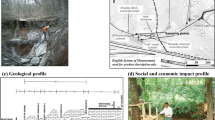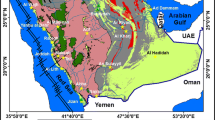Abstract
Extensive research has been done on investigation, monitoring, risk evaluation and land management to prevent formation of sinkholes and subsidences in karst terranes. Little emphasis is, however, given to the various processes and methodologies with respect to their remediation. Sinkholes are a surface symptom of complicated erosion and deformation processes that occur on the surface and in the subsurface. The specific method or combination of methods used to mitigate a sinkhole or subsidence depends on the complexity of the conceptual site model composed of influencing factors and triggering mechanisms, depth and lateral extent of instability, impact on existing infrastructure, and existing and reasonably anticipated land uses. Many sinkhole and subsidence rehabilitation methods including dynamic compaction, construction of inverted filters, compaction grouting and construction of water plugs are presented; however, each sinkhole must be treated uniquely when a decision is made on the most appropriate rehabilitation method. A case study was presented to illustrate how the conceptual site model and remedial alternative analysis approach were used to determine the preferred method for sinkhole remediation.






Similar content being viewed by others
References
Anikeev AV (1999) Casual hydrofracturing theory and its application for sinkhole development prediction in the area of Novovoronezh Nuclear Power House-2 (NV NPH-2), Russia. In: Beck BF, Pettit AJ, Herring JG (eds) Hydrogeology and engineering geology of sinkholes and karst. A.A Balkema, Rotterdam, pp 77–83
Beck BF (2004) Soil piping and sinkhole failures. In: Culver DC, White WB (eds) Encyclopedia of caves. Elsevier Academic Press, Cambridge, pp 521–526
Beck BF, Zhou W (2002) Management of the discharge and quality of highway stormwater runoff in karst areas, Report for Federal Highway Administration under Contract DTFH61-93-R-00183. U.S. Department of Transportation, Washington
Benson R, Yuhr LB (2016) Site characterization in Karst and Pseudokarst Terraines, practical strategies and technology for practicing engineers, hydrologists and geologists. Springer, Berlin
Ford D, Williams P (1989) Karst geomorphology and hydrology. Unwin Hyman, London
Friend S (2002) Sinkholes. Pineapple Press Inc, Sarasota, p 95
Gutierrez F, Guerrero J, Lucha P (2007) A genetic classification of sinkholes illustrated from evaporate paleokarst exposures in Spain. Environ Geol. https://doi.org/10.1007/s00254-007-0727-5
Keith JH, Bassett JL, Duwelius JA (1995) Modification of highway runoff quality by sinkhole drainage structures, Highway 37 improvement project, Lawrence County, Indiana. In: Beck BF (ed) Karst geohazards engineering and environmental problems in Karst Terrane. A. A Balkema, Rotterdam, pp 273–284
Kleinhans I, Van Rooy JL (2016) Guidelines for sinkhole and subsidence rehabilitation based on generic geological models of a dolomite environment on the East Rand, South Africa. J Afr Earth Sci 117:86–101
Li GY, Zhou WF (2015) Karst paleo-collapses and their impacts on mining and the environment in northern China. In: Doctor DH, Land L, Stephenson JB (eds) Sinkholes and the engineering and environmental impacts of Karst: Proceedings of the fourteenth multidisciplinary conference, October 5–9, Rochester, Minnesota: NCKRI symposium 5. Carlsbad, New Mexico: National Cave and Karst Research Institute
Sharp TM (1997) Mechanics of formation of cover collapse sinkholes. In: Beck BF, Stephenson JB (eds) Engineering geology and hydrogeology of Karst Terranes. A. A Balkema, Rotterdam, pp 29–36
Sharp TM (2003) Cover-collapse sinkhole formation and soil plasticity. In: Beck BF (ed) Sinkholes and the engineering and environmental impacts of karst. Geotechnical Special Publication No. 122, American Society of Civil Engineers, Reston, Virginia, pp 110–123
Sowers GF (1996) Building on sinkholes: design and construction of foundations in karst terrain. ASCE Press, New York, p 202
U.S. Army Corps of Engineers (2012) Environmental quality, conceptual site models, EM 200-1-12, 28 December
Waltham AC, Fookes PG (2003) Engineering classification of karst ground conditions. Q J Eng Geol Hydrogeol 36:101–118
Waltham T, Bell FG, Culshaw MG (2005) Sinkholes and subsidence: Karst and cavernous rocks in engineering and construction. Springer, Berlin
Williams P (2003) Dolines. In: Gunn J (ed) Encyclopedia of caves and karst science. Routledge, Abingdon, pp 304–310
Zhou W, Beck BF (2008) Management and mitigation of sinkholes on karst lands: an overview of practical applications. Environ Geol 55(4):837–851
Zhou W, Beck BF (2011) Engineering issues on karst. In: van Beynen PE (ed) Karst management. Springer, Dordrecht
Zhou W, Beck BF, Green T (2003) Evaluation of a peat filtration system for treating highway runoff in a karst setting. Environ Geol 44:187–202
Zhou W, Beck BF, Josefczyk RC (2005) Disposal of wastes in sinkholes: hydrogeological significance, environmental implications, and appropriate application of dye tracing. Prof Geol 42(6):46–51
Author information
Authors and Affiliations
Corresponding author
Additional information
This article is a part of the Topical Collection in Environmental Earth Sciences on Karst Hydrogeology: Advances in Karst Collapse Studies, edited by Dr. Zhou Wanfang.
Rights and permissions
About this article
Cite this article
Zhou, W., Lei, M. Conceptual site models for sinkhole formation and remediation. Environ Earth Sci 76, 818 (2017). https://doi.org/10.1007/s12665-017-7129-0
Received:
Accepted:
Published:
DOI: https://doi.org/10.1007/s12665-017-7129-0




